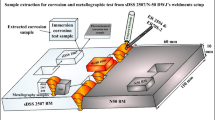Abstract
In this study, the corrosion and tribocorrosion behavior of additive manufactured (AM) 316L is investigated and compared to wrought 316L. The experiments were performed in both a 0.9 wt% NaCl solution and a simulated body fluid based on the protein albumin. The results are interpreted based on the analysis of the microstructure, inherent AM porosities and surface roughness. The results confirm that the AM samples present a substandard behavior compared to the wrought materials due to the higher surface area caused by the voids inherent to the AM process.













Similar content being viewed by others
References
Olsson COA, Landolt D (2001) Film growth during anodic polarization in the passive region on 304 stainless steel with Cr, Mo and W additions studied with EQCM and XPS. J Electrochem Soc 148:B438–B449
Olsson COA, Landolt D (2003) Passive films on stainless steels-chemistry, structure and growth. Electrochim Acta 48:1093–1104
Jemmely P, Mischler S, Landolt D (1999) Tribocorrosion behaviour of Fe–17Cr stainless steel in acid and alkaline solutions. Tribol Int 32:295–303
Wang Z et al (2016) Effect of proteins on the surface microstructure evolution of a CoCrMo alloy in bio-tribocorrosion processes. Colloids Surf B Biointerfaces 145:176–184
Bidiville A et al (2007) Effect of surface chemistry on the mechanical response of metals in sliding tribocorrosion systems. Wear 263:207–217
Albrektsson T, Johansson C (2001) Osteoinduction, osteoconduction and osseointegration. Eur Spine J 10:96–101
Sin JR (2015) Investigation of the corrosion and tribocorrosion behaviour of metallic biomaterials. Doctoral Thesis, Luleaa University of Technology
Yan Y (2006) Corrosion and tribocorrosion behaviour of metallic orthopaedic implant materials. Doctoral Thesis, The University of Leeds
Vaithilingam J et al (2016) The effect of laser remelting on the surface chemistry of Ti6al4V components fabricated by selective laser melting. J Mater Process Technol 232:1–8
Yamaguchi H, Fergani O, Pei-Ying W (2017) Modification using magnetic field-assisted finishing of the surface roughness and residual stress of additively manufactured components. CIRP Ann Manuf Technol 66:305–308
Henry P, Takadoum J, Bercot P (2009) Tribocorrosion of 316L stainless steel and TA6V4 alloy in H2SO4 media. Corros Sci 51:1308–1314
Mischler S (2008) Triboelectrochemical techniques and interpretation methods in tribocorrosion: a comparative evaluation. Tribol Int 41:573–583
Mischler S, Debaud S, Landolt D (1998) Wear accelerated corrosion of passive metals in tribocorrosion systems. J Electrochem Soc 145:750–758
Munoz AI, Espallargas N (2011) Tribocorrosion mechanisms in sliding contacts. In: Landolt D, Mischler S (eds) Tribocorrosion of passive metals and coatings. Woodhead Publishing, Lausanne
von der Ohe CB, Johnsen R, Espallargas N (2010) Modeling the multi-degradation mechanisms of combined tribocorrosion interacting with static and cyclic loaded surfaces of passive metals exposed to seawater. Wear 269:607–616
Papageorgiou N, Mischler S (2012) Electrochemical simulation of the current and potential response in sliding tribocorrosion. Tribol Lett 48:271–283
Espallargas N, Johnsen R, Torres C (2013) A new experimental technique for quantifying the galvanic coupling effects on stainless steel during tribocorrosion under equilibrium conditions. Wear 307:190–197
Vieira AC et al (2012) Mechanical and electrochemical deterioration mechanisms in the tribocorrosion of Al alloys in NaCl and in NaNO\(_3\) solutions. Corros Sci 54:26–35
Diomidis N et al (2010) Tribocorrosion of stainless steel in sulfuric acid: Identification of corrosion-wear components and effect of contact area. Wear 269:93–103
Favero M, Stadelmann P, Mischler S (2006) Effect of the applied potential of the near surface microstructure of a 316L steel submitted to tribocorrosion in sulfuric acid. J Phys D Appl Phys 39:3175–3183
Perret J et al (2010) EBSD, SEM and FIB characterisation of subsurface deformation during tribocorrosion of stainless steel in sulphuric acid. Wear 269:383–393
Bazzoni A, Mischler S, Espallargas N (2013) Tribocorrosion of pulsed plasma-nitrided CoCrMo implant alloy. Tribol Lett 49:157–167
Wei R et al (2004) High-intensity plasma ion nitriding of orthopedic materials: part I, tribological study. Surf Coat Technol 186:305–313
Lanning BR, Wei R (2004) High intensity plasma ion nitriding of orthopedic materials: part II, microstructural analysis. Surf Coat Technol 186:314–319
Elik C et al (2008) Effects of plasma nitriding on mechanical and tribological properties of CoCrMo alloy. Surf Coat Technol 202:2433–2438
Pichon L et al (2010) CoCrMo alloy treated by floating potential plasma assisted nitriding and plasma based ion implantation: influence of the hydrogen content and of the ion energy on the nitrogen incorporation. Surf Coat Technol 204:2913–2918
Ozturk O, Trkan U, Eroglu A (2006) Metal ion release from nitrogen ion implanted CoCrMo orthopedic implant material. Surf Coat Technol 200:5687–5697
Zavieh AH, Espallargas N (2016) Effect of 4-point bending and normal load on the tribocorrosion-fatigue (multi-degradation) of stainless steels. Tribol Int 99:96–106
Zavieh AH, Espallargas N (2016) The role of surface chemistry and fatigue on tribocorrosion of austenitic stainless steel. Tribol Int 103:368–378
Zavieh AH, Espallargas N (2017) The effect of friction modifiers on tribocorrosion and tribocorrosion-fatigue of austenitic stainless steel. Tribol Int 111:368–378
McCafferty E (2009) Thermodynamics of corrosion: pourbaix diagrams. Introduction to corrosion science. Springer, New York, pp 95–117
Vidal CV, Munoz AI (2011) Electrochemical aspects in biomedical alloy characterization: electrochemical impedance spectrosopy, biomedical engineering, trends in materials science. InTech, London
Galant NJ (2012) Disulfidicity: a scale to characterize the disulfide bond strength via the hydrogenation thermodynamics. Chem Phys Lett 539:11–14
Acknowledgements
The authors would like to thank Cristian Torres for his help in conducting the experiments and Vegard Brtan for his help with the SLM process. The authors would like to acknowledge the support from the research center ‘SFI Manufacturing’ and the MKRAM project (Grant No. 248243), which is sponsored by the Research Council of Norway and industrial partners.
Author information
Authors and Affiliations
Corresponding author
Ethics declarations
Conflict of interest
On behalf of all authors, the corresponding author states that there is no conflict of interest.
Rights and permissions
About this article
Cite this article
Stendal, J., Fergani, O., Yamaguchi, H. et al. A Comparative Tribocorrosion Study of Additive Manufactured and Wrought 316L Stainless Steel in Simulated Body Fluids. J Bio Tribo Corros 4, 9 (2018). https://doi.org/10.1007/s40735-017-0125-9
Received:
Revised:
Accepted:
Published:
DOI: https://doi.org/10.1007/s40735-017-0125-9




